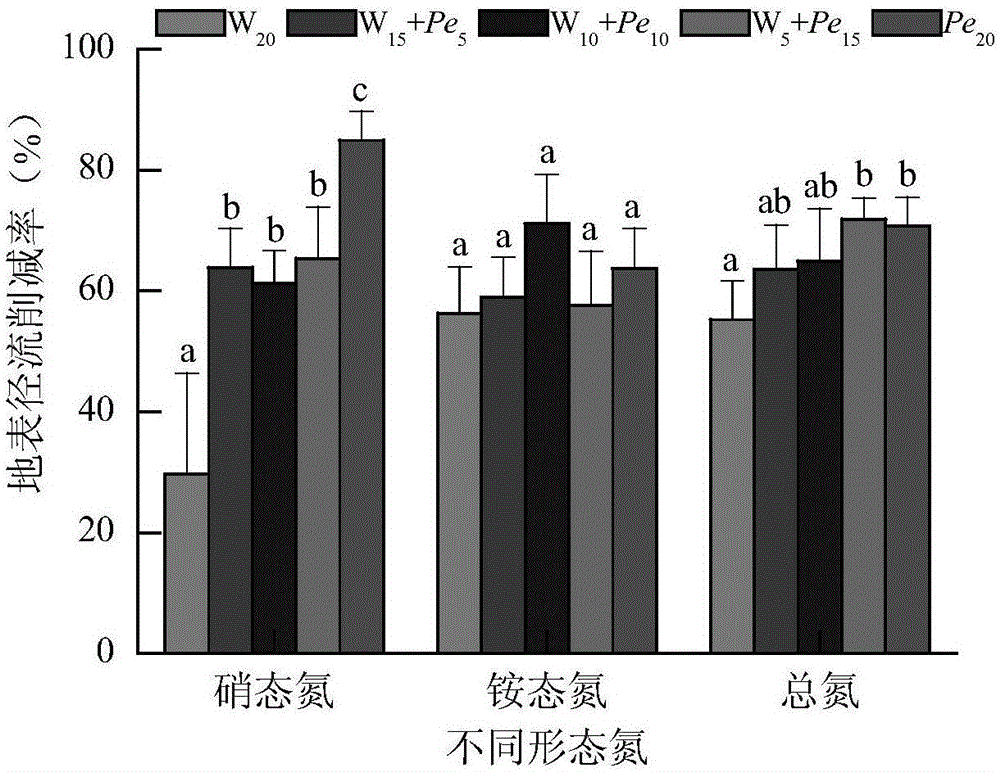Construction method of riparian buffer strips for reducing non-point source pollution of broken farmland landscape
A non-point source pollution and farmland landscape technology, applied in chemical instruments and methods, construction, biological water/sewage treatment, etc., can solve the problems of high cost of vegetation planting and maintenance, neglect of economic benefits of buffer zone, etc., to improve ecological benefits, Good water and soil retention capacity, dense stems and leaves
- Summary
- Abstract
- Description
- Claims
- Application Information
AI Technical Summary
Problems solved by technology
Method used
Image
Examples
Embodiment 1
[0029] A method for constructing a mountainous river bank buffer zone utilizing fast-growing pastures, comprising the following steps:
[0030] (1) Select the riparian land parallel to the river and about 20m between farmland 1 and the river as the construction area;
[0031] (2) To form a relatively gentle terrain with a ground slope of less than 5% by leveling the land for preliminary transformation of the selected area, in order to plant fast-growing grasses;
[0032] (3) Construction of agricultural non-point source runoff catchment water distribution system: build a square water storage ditch with concrete and bricks between the construction area of the buffer zone and the farmland, with a cross-section parallel to the river, and the width and depth are 0.4m respectively , by excavating drainage ditches and connecting farmland drainage ditches to collect farmland receding water and rainfall runoff from farmland confluence, and build a zigzag overflow weir 0.2m above the...
Embodiment 2
[0037] As the method described in embodiment 1, the difference is that, in order to evaluate the buffering and pollution-reducing effect of different width combinations hybrid pennisetum 3 riparian zones, 5 treatment plots are set in the hybrid pennisetum planting width in step (4), altogether, Each treatment plot was arranged perpendicular to the river bank, and each treatment was set up with 2 replicates, which were divided into 10 test plots with a length × width of 20m × 2.5m. The planting patterns of hybrid pennisetum in different treatment zones were 0m abandoned weed land (W20), 15m abandoned weed land+5m hybrid pennisetum (W15+Pe5), 10m abandoned weed land+10m hybrid pennisetum (W10 +Pe10), 5m abandoned weed land +15m hybrid pennisetum (W5+Pe15) and 20m hybrid pennisetum (Pe20).
[0038] After one year of construction, the concentration reduction rates of total nitrogen, ammonia nitrogen and total phosphorus in the surface runoff of different pennisetum hybrid planting...
Embodiment 3
[0040] As in the method described in Example 2, the difference is that, in order to evaluate the response ability of reducing the extreme non-point source pollution risk conditions of the hybrid pennisetum riparian zone in different width combinations, in step (5), the local customary fertilization rate is used as a reference Standard application of inorganic compound fertilizers (N:P 2 o 5 :K 2 O=15:15:15, 45%) 1500kg hm -2 (high concentration) and 750kg·hm -2 (Low concentration) Simulate two concentration eutrophication risk scenarios, discharge the river water as simulated runoff water into the farmland after fertilization, and make the runoff water flow into the buffer zone water storage ditch along the farmland drainage ditch and overflow to the buffer zone Inside, the concentration of different forms of nitrogen and phosphorus in the outflow runoff and the change characteristics of the outflow runoff flow were monitored.
[0041]Monitoring the concentration reduction...
PUM
 Login to View More
Login to View More Abstract
Description
Claims
Application Information
 Login to View More
Login to View More - R&D
- Intellectual Property
- Life Sciences
- Materials
- Tech Scout
- Unparalleled Data Quality
- Higher Quality Content
- 60% Fewer Hallucinations
Browse by: Latest US Patents, China's latest patents, Technical Efficacy Thesaurus, Application Domain, Technology Topic, Popular Technical Reports.
© 2025 PatSnap. All rights reserved.Legal|Privacy policy|Modern Slavery Act Transparency Statement|Sitemap|About US| Contact US: help@patsnap.com



